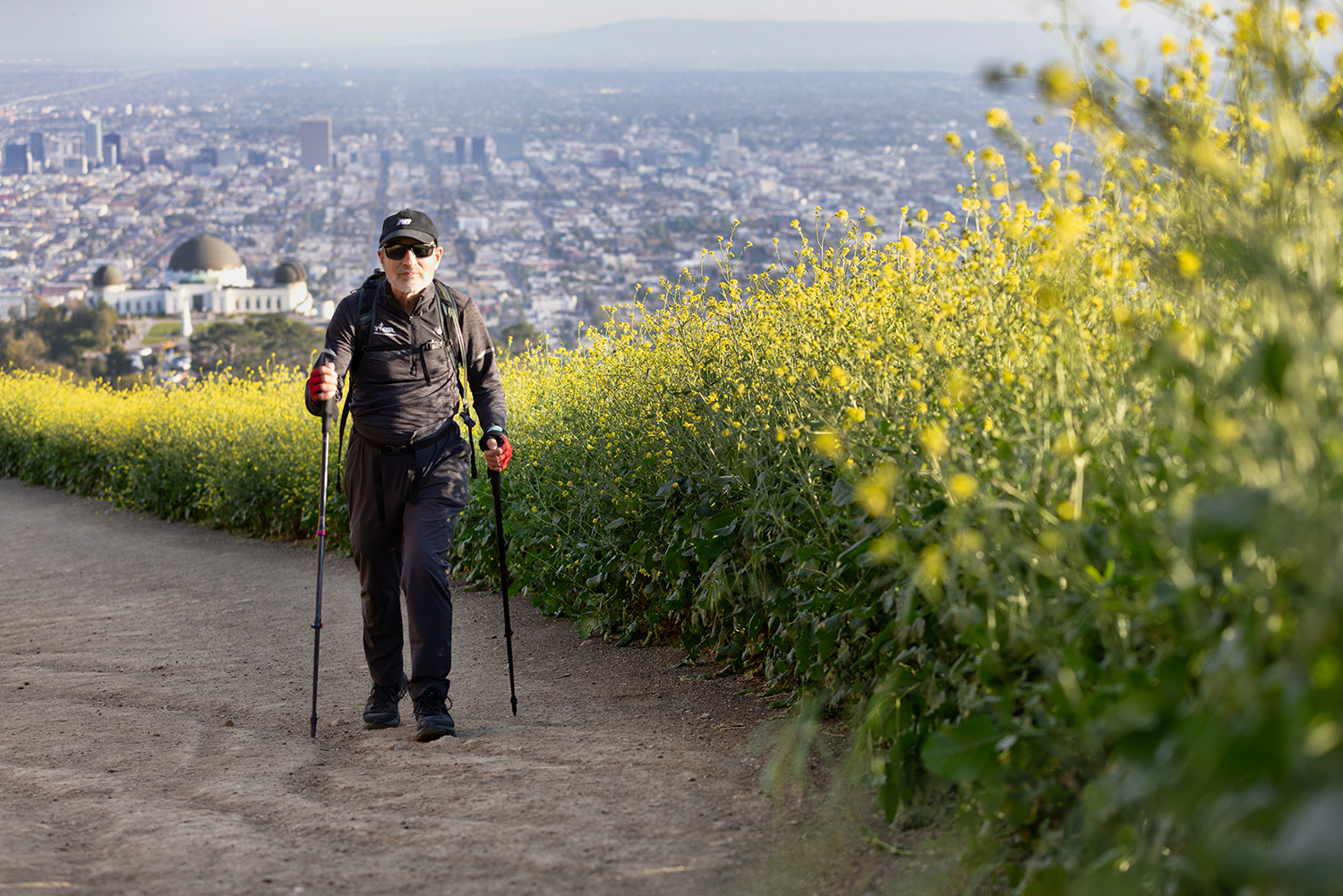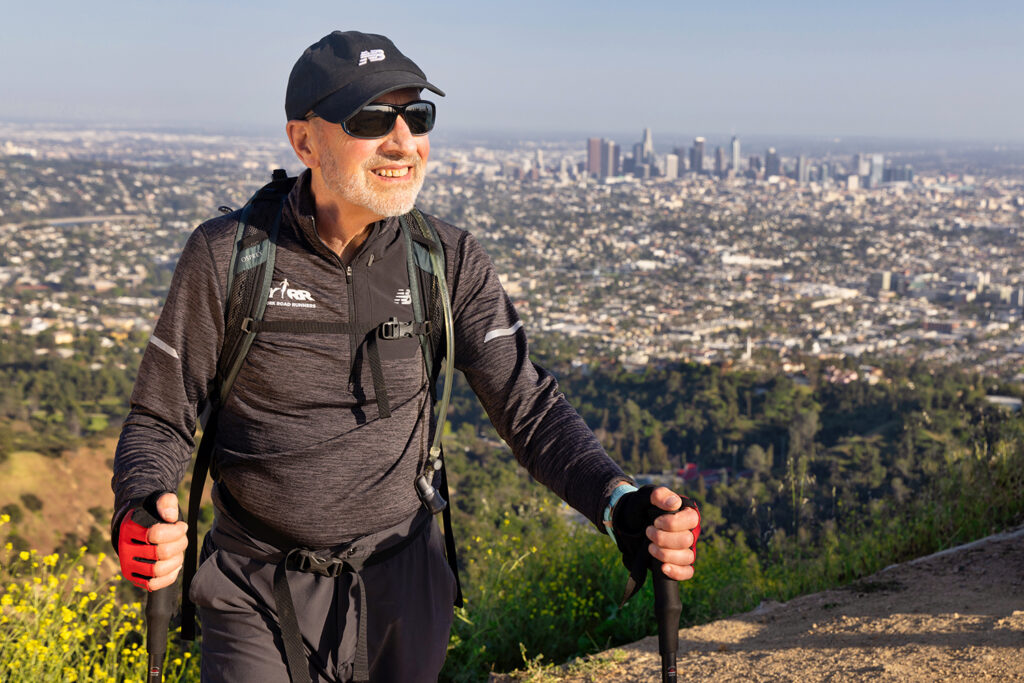04.27.2023
By uscbknpt
Back in Action

Bob Parsons recovers from a severe biking accident with the support of experts from USC’s unique Spine Physical Therapy Fellowship.
BY DANIEL P. SMITH
ON AUGUST 9, 2021, TWO WEEKS FROM HIS 75TH BIRTHDAY, Bob Parsons biked down a paved road in Los Angeles’ Griffith Park, a route he had traversed dozens of times before. A fitness fanatic who has completed 28 marathons and numerous triathlons, Parsons’ legs moved in a smooth, familiar cadence. The wind brushed across his face.
Then, darkness.
“I couldn’t tell you what happened,” Parsons says. “I don’t know.”
Parsons estimates he was unconscious for five minutes. When he awoke, a frightening reality consumed his mind: He could not move his arms or legs.
“I was sure I was paralyzed,” the now 76-year-old Los Angeles resident says.
The first steps toward recovery
Transported to Huntington Hospital in Pasadena, Parsons faced an extensive list of injuries, including a mild brain injury, a spinal cord injury with transient paralysis, a C2 fracture and dislocation with C2-3 retrolisthesis and a sliced vertebral artery.
“You’re lucky to be alive,” he heard more than one medical staffer say.
After a few days in Huntington Hospital’s intensive care unit, Parsons was transferred to a regular bed. Early the next morning, physical therapists visited and encouraged Parsons to try sitting up and maybe even walking. With the help of pain medication, therapists and a walker, Parsons rose to his feet. Hesitant and dazed, he shuffled four steps ahead, then four steps back.
“It was the most serious pain I have ever experienced in my life,” Parsons says. “But it was worth it. I had walked!”
In the months that followed, Parsons — his neck and head held stable by a halo for 10 weeks — endured extensive acute, sub acute and outpatient rehabilitation to restore a base level of function. For an independent man accustomed to being on the go and at the tip of the septuagenarian fitness spear, the struggle to perform basic tasks weighed heavily on his mind and his soul. Recovery was both a physical and mental test.
“There are dark moments, especially at night,” Parsons admits.
Turning to spine physical therapy
In the summer of 2022, Parsons began seeing Lisa Fukuzato, an assistant professor of clinical physical therapy at USC, for neurologic physical therapy. Nearly a year after his accident, Parsons had almost fully recovered neurologically and faced little trouble completing daily living tasks.
After only a handful of sessions, Fukuzato suggested Parsons pursue spine physical therapy and referred him to Justin Lantz, the director of USC’s pioneering Spine Physical Therapy Fellowship. Leading one of only four spine therapy fellowships in the United States, Lantz possessed the technical expertise, collaborative mindset and intimate knowledge of spinal injuries to oversee the next stage of Parsons’ recovery.
In his initial August 2022 visit with Parsons, Lantz noted Parsons’ reduced range of motion as well as weakness in his arms and legs. He listened to Parsons describe persistent pain in his neck and shoulders. He also recognized Parsons’ hesitancy about reinjuring his spinal cord, a source of ongoing anxiety for Parsons and perhaps his most significant hurdle to a more fulfilling recovery.
But Lantz noticed something else in Parsons: a fervent commitment to resume physical activity. While Parsons felt his days of running and biking were over given the danger of a repeat spinal cord injury, he told Lantz he wanted to hike on a regular basis.
“I set a high bar for Justin, and he never gave me a hint it couldn’t be reached,” Parsons says.
Partners in progress
Lantz outlined a systematic, solutions-oriented program for Parsons, one that involved Parsons in the clinical decision making.
“Bob had seen the MRIs, heard the specialists and knew the issues he had, so it wasn’t a question of identifying problems,” says Lantz, a dual appointed assistant professor of clinical physical therapy and clinical family medicine at USC. “We needed to understand what he was feeling and how to approach it.”
On the physical front, Lantz started Parsons on low-level trunk range of motion, spine and joint mobilization, soft tissue mobility and therapeutic exercises. He later incorporated weight training and balance exercises.
In tandem, Lantz counseled Parsons on his spinal cord injury, pain management and neural processing of pain. He tasked Parsons to maintain a daily pain journal, noting where pain occurred, when and the pain level. During sessions, he probed Parsons with questions.
“Justin was always listening to how I felt, monitoring my progress and making adjustments to the program,” Parsons says.
Parsons responded with an equally earnest focus. He arrived at appointments with a notebook in hand and peppered Lantz with his own questions.
“Justin took my recovery seriously and from day one it was a collaborative process,” Parsons says.

Making progress and setting new goals
Parsons calls himself “fortunate” to have access to Lantz and his group, including DPT student Leana Mosesian, who has been assisting with Parsons’ most recent appointments. Like Lantz, Mosesian is absorbing Parsons’ admittedly hefty barrage of questions and driving Parsons’ recovery with thoughtfulness, care and clinical know-how.
“They continue applying every bit of training and knowledge to my injury and recovery, unraveling layers of mysteries and helping me progress,” Parsons says.
Parsons is now hiking 2-3 times each week, often in Griffith Park. While neck and shoulder pain remain, it is sporadic these days, not constant. Parsons has regained much of his strength and is progressing as he had hoped. Above all, he’s more confident and assured.
“I’ve gotten encouragement every step of the way, and that’s been key for me,” Parsons says. “I’ll never be the same as before, but Justin and his group have helped me recalibrate my outlook to what I can do.”
In fact, Parsons recently divulged his newest goal to Lantz: to hike Mount Wilson.
“We’ll get you there,” Lantz replied.
Parsons smiled and nodded in agreement. After all, he had no reason to think otherwise.

